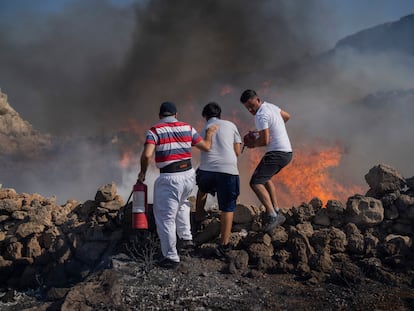From scarfs to shorts: South America sees record-high temperatures in the dead of winter
Buenos Aires saw its hottest beginning to August in 117 years while the thermometer soared to 102.2ºF in some areas of southern Brazil


South America is recording some of its warmest winter temperatures in history. In Argentina, Buenos Aires saw its hottest beginning to August in 117 years, with the thermometer soaring above 86ºF (30ºC). Some areas of southern Brazil reached 102.2ºF (39°). In Paraguay, the region of Chaco saw the temperature hit 98.6ºF (37°C) — a record high not seen since 1981. Peru and Ecuador have also set new records for warm winter weather.
Chile, meanwhile, is seeing its highest winter temperatures of the last 72 years. In Vicuña, in the northern region of Coquimbo, the thermometer soared to 98.6ºF (37°C) last week — the second-highest temperature recorded in Chile between June and September since 1951. The high temperatures are also having an impact on snow melt in the Chilean Alps. Experts warn that if measures are not taken to address climate change, it will only get hotter.
Chile’s Environment Minister Maisa Rojas pointed out that the high winter temperatures are just the latest extreme weather phenomenon to hit the country, which saw fires in February, floods as a result of torrential rains in June and is now facing unprecedented highs. “What to do? We know what the solution is: stop burning fossil fuels at once,” the minister posted on social media.
Climatologist Raúl Cordero says the situation has been compounded by El Niño, a cycle that sparks hotter weather, as well as more water vapor and rainfall. “Climate change causes temperatures to rise every year, but the El Niño phenomenon has led records to be broken,” he explained. In mid-July, the International Research Institute for Climate and Society (IRI) reported that El Niño conditions had strengthened from weak to moderate.
According to Cordero, the situation in Chile is due to the fact that the temperature of the tropical Pacific Ocean, off the coasts of Ecuador and Peru, is the warmest it has been for the last 25 years. “We are still to see more high temperatures in the north of Chile, in the north of Paraguay and in the south of Brazil,” he says by phone from the Netherlands. Cordero warns that while the record-breaking winter highs are of concern, there are other trends that are even more worrying. As an example, he points to the Chilean city of Iquique, which has registered nearly 60 consecutive days of high temperatures due to the warmth of the waters of the tropical Pacific.
Alex Godoy, director of the sustainability center at the University for Development in Chile, also points out that while El Niño is associated with greater rainfall, the region hasn’t seen that much rain this year. “What we are seeing here is a change in the pattern of frequencies and intensity of temperatures. It is not an isolated phenomenon,” he explains. Climatologists hope that it will rain in the second half of August and the first half of September.
Public health and climate change expert Yasna Palmeiro-Silva, from University College London, projects that South America will not only have a very short winter with abnormally high temperatures, but also a very short spring. “We should have quite summery days from September. Since 2010, the region, particularly Chile, no longer has four distinct seasons, but rather a winter and a long summer, with very short autumns and springs,” she says.
“We are gradually saying goodbye to winter,” says Cordero. “It is not even remotely as rainy as before. In the last decade, it has rained 30% less than in previous decades in Chile.”
Hot winters, short springs and autumns, and dry summers alter the natural cycles of ecosystems that allow South America, among other things, to develop an agricultural and fishing sector. “What the models suggest,” Palmeiro-Silva points out, “is that with a heat wave in winter, the soil dries up, the snow melts much faster and there is no source of fresh water for the summer. What’s more, the summer is very dry, which affects agriculture, water for human consumption and makes the vegetation much drier. If the vegetation is dry and high temperatures are recorded, this leads to forest fires.”
Sign up for our weekly newsletter to get more English-language news coverage from EL PAÍS USA Edition
Tu suscripción se está usando en otro dispositivo
¿Quieres añadir otro usuario a tu suscripción?
Si continúas leyendo en este dispositivo, no se podrá leer en el otro.
FlechaTu suscripción se está usando en otro dispositivo y solo puedes acceder a EL PAÍS desde un dispositivo a la vez.
Si quieres compartir tu cuenta, cambia tu suscripción a la modalidad Premium, así podrás añadir otro usuario. Cada uno accederá con su propia cuenta de email, lo que os permitirá personalizar vuestra experiencia en EL PAÍS.
¿Tienes una suscripción de empresa? Accede aquí para contratar más cuentas.
En el caso de no saber quién está usando tu cuenta, te recomendamos cambiar tu contraseña aquí.
Si decides continuar compartiendo tu cuenta, este mensaje se mostrará en tu dispositivo y en el de la otra persona que está usando tu cuenta de forma indefinida, afectando a tu experiencia de lectura. Puedes consultar aquí los términos y condiciones de la suscripción digital.
More information
Extreme heat: A chronicle of the hottest days on the planet
Últimas noticias
Maduro to be tried in the US for narcoterrorism and corruption
Maps of the US attack on Venezuela: Targets, airspace and deployed fleet
Venezuelans in exile: ‘This could be the end of a very dark chapter for Venezuela, but also the beginning of a time of uncertainty’
Key points of the military attack on Venezuela: Early morning bombings and a ‘captured’ president
Most viewed
- Alain Aspect, Nobel laureate in physics: ‘Einstein was so smart that he would have had to recognize quantum entanglement’
- David King, chemist: ‘There are scientists studying how to cool the planet; nobody should stop these experiments from happening’
- Mexico completes its trade shift with the entry into force of tariffs on China and countries without trade agreements
- Reinhard Genzel, Nobel laureate in physics: ‘One-minute videos will never give you the truth’
- Oona Chaplin: ‘I told James Cameron that I was living in a treehouse and starting a permaculture project with a friend’









































